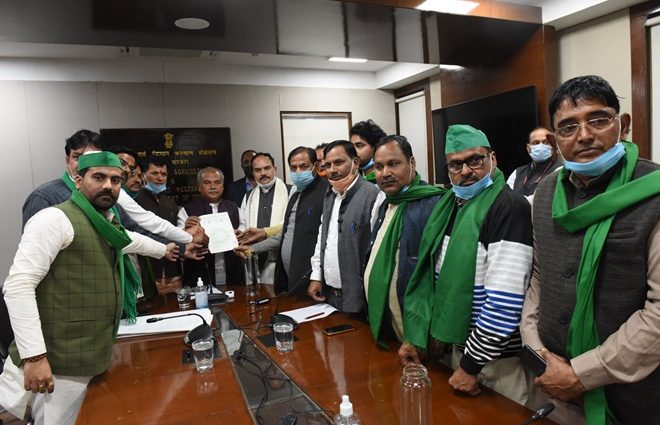Sachidanand
Punjab’s farmers started the agitation against the three farm laws demanding their repeal only after it was passed by Parliament in September whereas the laws were already in implementation since June 5, 2020 through Ordinances.
So, when the BJP is accusing Congress of doing politics, it is not without basis. But, which political party will close eyes when such an emotive issue comes on a platter? Probably BJP would have done the same, even more, had it been in opposition as seen from its past track record during ‘Anna Andolan’ or allowing ‘FDI in Retail’.
The insistence on repeal of these laws will do more harm to farmers, but help the opposition to score a point over Modi, maybe have a political victory. The benefits for the farming community lie with retention of the laws with suitable amendments, so that their interests are secured while Modi’s ego is not hurt either. A political victory may not be of any use to farmers compared to extracting a bigger deal – legal guarantee of MSP.
As Narendra Modi decides to take on the farmers’ protest head on by mobilising party workers, there has been a lot of falsehoods spread by a cross section of people affiliated with government or BJP. Neither the opposition, nor the farmer leaders are capable to counter these false narratives since the number of the organised paid messangers are not in thousands, but in lakhs and they are highly tech-savvy.
Kesri, a 36-year-old with two children, has been a Modi supporter for the past few years. As the only son, he is helping his father in agriculture, growing only a few crops in which minimum support prices (MSPs) are announced. He is aware of MSP. He also knows their crops are sold below MSP in the mandis. He is also aware of the current protest and the demand to legalise MSP. Still, he supports Modi and blindly accepts government’s argument and ready to economically suffer, indefinitely.
His refrain: “We have more than enough income from our land. For small benefits, I cannot go against Modiji. If farmers require, Modiji will give MSP.” His father in his 60s, however, thinks otherwise. Farmers should have legal rights over MSP, said Kesri’s father. There could be several Kesris in this country, already polarised with pro- and anti- Modi groups.
Despite the types of Kesri, farmers across the country have assembled in Delhi since November 26 to protest against the three farm laws. The Punjab farmers, who are leading the nationwide protest, have expressed fear that mandis will be closed and MSP system will be abolished after the laws. Despite assurance of the government, they are not convinced and demand legal guarantee for MSP.
Legal Guarantee for MSP
There has been demand for fixing the MSP on the Swaminathan formula, which suggests 50% profit over costs. The UPA government rejected the suggestion since MSPs used to be recommended by the Commission for Agriculture Costs and Prices (CACP) based on demand, supply and international prices of crops. Sensing an opportunity, Modi made it an election promise in 2014, to implement the Swaminathan commission, and MSP for the first time in the country became a political issue.
Later on, in Supreme Court the government gave an affidavit that the Swaminathan commission recommendation could not be implemented. Once that came to light, the farmer groups kept pressurising the government. Just before the 2019 poll, the government found a way out— it fixed MSP at 50% over cost of production (A2+FL), not the original suggestion to calculate the cost at C2 formula.
The result was 3-52% increase in MSP of kharif crops during 2018, year-on-year, which could have been even more had the government accepted the C2 formula. Still, that gave rise to a distortion between mandi prices and MSPs in 2018 and all subsequent seasons. What used to be around 10%, the difference between mandi rates and MSPs increased to 30-40%. This is the main reason why farmers started demanding implementation of the MSPs. Modi himself has admitted that the procurement has increased manifold after 2015. This also proves the widening gap between these two rates as the government policy says the official procurement has to be there on the request of state government when mandi prices fall below MSPs.
Before 2014, as the price gap between the two were not as wide, a little bit of procurement used to help increase mandi rates. Whereas despite more quantities procured by the government after 2014, many oilseeds and pulses crops rule 30% below MSPs in the initial 2-3 months of harvests when maximum arrivals take place in mandis.
There was no procurement of coarse cereals- maize, jowar and bajra as the policy on paper helps government to avoid procurement. As a result, no state government procures these cereals, nor FCI. Farmers continue to sell up to 50% below MSP, even as a “PM-Aasha” scheme continues to languish on paper.
ALSO READ:
Guidelines for Price Support Scheme
Guidelines for Price Deficiency Payment Scheme
Guidelines for Private Procurement & Stockist Scheme
MSP Comparison (Average UPA Vs BJP) Click here to enlarge

Remarks:
- It is evident that average annual increase in MSP was 8 to 12% during UPA regime while it is 1 to 5% in BJP regime
- Non procurement at MSP is a serious problem in last 3 years
(Sachidanand is an independent journalist. Views expressed by author are personal)
Image Source: PIB

